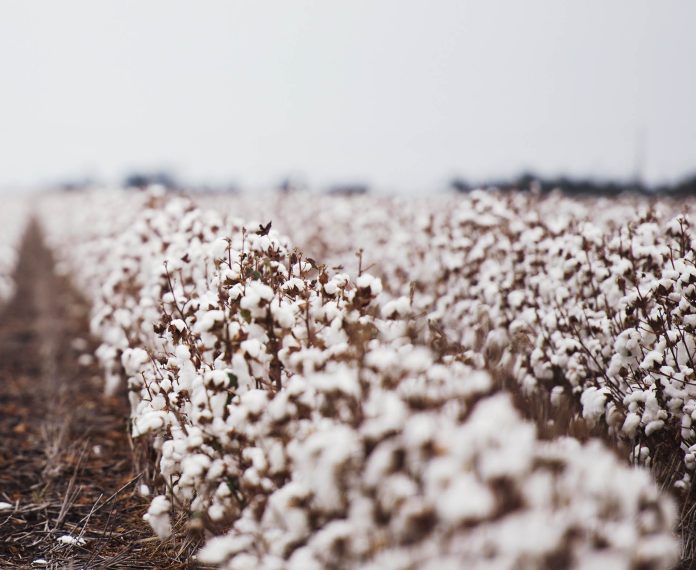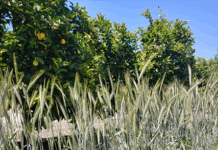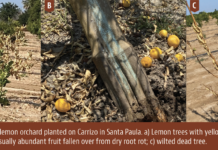Objectives of Research
- Develop and expand the cotton progeny and breeding populations segregating for Fusarium wilt race 4 (FOV4) resistance. (efforts are roughly split between Upland/Acala types of cotton and Pima germplasm).
2. Evaluate resulting progeny, breeding lines, and germplasm for FOV resistance.
3. Utilizing selected materials, maintain seed supplies through progeny propagation and breeding population increases at field location(s) in California and in greenhouses as necessary for limited seed entries.
4. As selected germplasm are advanced, also conduct trials to evaluate growth characteristics and yield performance (growth habit, growing season length requirements and yield performance) at West Side Research Center location
5. Identify breeding lines and germplasm with improved combinations of FOV race 4 resistance, fiber quality, and yield for release and availability to breeders and seed companies as appropriate.
Planting tolerant/resistant varieties is an effective strategy to manage FOV4 damage and losses in cotton. Progress has been made by University of California and USDA, ARS, and the private companies from information and results generated by this and other FOV4 research projects funded through California cotton growers/producers. Research efforts have identified and developed tolerant/resistant Pimas, as have made some progress in identifying improved FOV4 resistance in Upland cultivars.
Field evaluations have provided information for a number of generalizations: (1) most Pima cultivars show more severe symptoms and suffer higher levels of stunting and plant mortality from FOV4 than seen with most Uplands or non-Acala, and Acala cotton; (2) some moderate to highly-resistant commercial Pima cultivars have been identified from several seed companies and private breeders; and (3) several experimental Pima germplasm or breeding lines with moderate to high resistance to FOV4 have been identified, developed, and publicly released (SJ-FR01 to SJ-FR09) by the Univ. of California and USDA-ARS. These germplasm lines have helped to increase the genetic base for FOV4 resistance in Pima Cotton.
Since 2013, more than 4,000 entries and developed progeny have been evaluated in infested FOV4 fields and a portion (1/4) in the greenhouse using artificial FOV4 inoculation. Our primary objectives have been to identify/develop additional Pima cultivars, and evaluate and develop the Upland gene pool for improved FOV4 tolerant germplasm. Efforts have included introducing a known FOV4 dominant gene that has shown resistance in Pima (e.g., Pima-S6) into Upland cultivars, as well as, introducing tolerant gene(s) from identified Upland tolerant lines from our research obtained from the USDA-ARS Cotton Germplasm Collection and University-breeding programs into elite or improved yield and fiber quality cotton lines.
For the breeding efforts, entries and progeny have been planted in naturally-infested FOV4 fields and seeded in 5-by-1 meter plots and replicated three times. During the growing season, plant responses to inoculum pressure were assessed through evaluations of root and stem vascular staining levels, plant mortality, foliar wilt symptoms and measures of relative plant vigor. Selected cotton entries used as parents to make crosses and progeny developed from these parental entries (F1 populations) were also inoculated with FOV-4 and grown under greenhouse conditions for rating. In addition, resistant/tolerant varieties or germplasm may not express similar modes of inheritance of resistance when they are derived from different genetic backgrounds or are challenged by different Fusarium types or races of different geographic origin. The postulated pathogenicity or mode of infection mechanisms and the inheritance of Fusarium resistance significantly differ among races for cotton entries or lines. Previous reports indicated FOV4 resistance is associated with a complex allelic-recombination and duplicated marker-genes between cotton chromosomes 14 and 17. Genomic islands or regions on chromosomes 3, 6, 8, 11, and 25 have also been reported to be associated with allelic dosage for FOV-4 tolerance. Additional analyses revealed that cotton lines and progeny share resistance genes for plant defense against Fusarium races (1, 4, and 7).
In Upland cotton, germplasm with improved levels of FOV-4 tolerance have been identified, and new breeding lines are being developed by USDA-ARS and the University of California with the support of the CA Cotton Alliance and the CA Cotton Growers and Ginners Association. From 2019, more than 150 Upland breeding lines are being evaluated to validate their higher FOV-4 levels of tolerance and to identify the best FOV-4 tolerant lines for releasing to the public and private researchers and breeders. In Figure 1, the evaluation of FOV-4 results and the progress of selection of a few breeding lines from 2016 to 2018 are compared with check lines with known level of FOV-4 resistance (Shorty-Upland, Pimas: PS7 and P3-39 susceptible and PS6 resistance).
In Pima cotton, Egyptian and Peruvian Pima or long staple cotton have been evaluated for relative levels of FOV-4 resistance. A half-dozen of these lines were selected to make crosses and develop progeny that eventually will derive new and more diverse Pima germplasm resistance to FOV4. From 2019, more than 300 Pima variants (Gossypium barbadense L.) from the country of Uzbekistan are being evaluated to identify new sources of FOV4 resistance for developing novel germplasm.
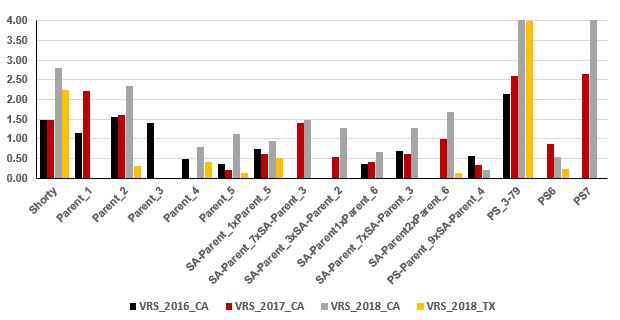
Significance of Research
Fusarium wilt [Fusarium oxysporum f. sp. vasinfectum Atk. Syn & Hans (FOV)] of cotton (Gossypium spp.) in California has long been considered a serious fungal disease for cotton. Some races of this disease were first noted in 1959 in California (Garber and Paxman, 1963), and the number of infested sites remained relatively limited until the mid-1970’s. Before 2003, FOV in California was thought to be primarily caused by race 1. Race 1 of FOV is typically found in sandy soils, with the most severe, economic impacts found when the disease organism is present in an interaction with root-knot nematodes (Bell, 1984; Veech, 1984). Susceptibility to FOV, particularly race 1 FOV is increased by the effect of the nematode’s wounds (Garber et al., 1979). In 2003, UC Davis scientists (Kim et al., 2005) identified a race 4 isolate of FOV in California soils. Race 4 of FOV was first identified in India on Asiatic cottons and was not previously identified as a problem in the U.S. Recent field investigations (Kim et al., 2005; Ulloa et al., 2006) have found race 4 FOV in clay loam and loam soils, in which root knot nematode populations and root damage symptoms were largely absent.
The introduction of new genetic variability or genetic diversity into elite cotton germplasm is difficult and the breeding process slow. When breeders use new and exotic germplasm sources, which possess resistance disease genes, to introduce genetic variability, large blocks of undesirable genes are also introgressed during the recombination between the two parental lines (linkage drag). This linkage drag has limited the use of such germplasm. In terms of the maintenance of elite germplasm with elite genes/traits, very high constraints are placed on today’s cotton breeders. However, the competitiveness of the cotton industry will be dependent upon continuing improvements of traits such disease resistance, fiber quality, and yield. We feel that improvements in host-plant resistance currently is the most economic and effective strategy for managing Fusarium Race 4 for continuing cotton production in the San Joaquin Valley region of California. Continuing the development of resistant cultivars or germplasm to FOV is important for reducing yield losses and reducing further expansion of the pathogen.
The primary areas of work in this project include the following:
- Maintain and further develop access to one (preferably two) field test sites infested with race 4 FOV as well as greenhouse space to continue resistant germplasm testing in the San Joaquin Valley.
- Using field and greenhouse screening sites available to us, test cotton progeny and breeding lines and continue making crosses with potential for improved FOV-4 resistance. Collect seed from self and open pollinated cultivars of interest/improved FOV-4 resistance or other traits, delint and prepare seed for plantings for further FOV-4 testing of segregating populations and for seed increases necessary to allow further agronomic testing for yield and quality, plus to provide seed for interested breeders for further development.
- A link to ongoing plant genetics program in FOV resistance of Dr. Ulloa and his continuing molecular work is a vital part of this project plan. Identification of developed breeding lines and germplasm with improved FOV resistance through molecular breeding increases the need for molecular markers because molecular markers facilitate selection of resistant cottons, and decrease cost, time, and the risk associated with subjective greenhouse or field phenotypic evaluations. Molecular markers can also help in the identification of the genes that provide host-plant resistance against FOV.
- Under current arrangements with USDA-ARS cooperators, one additional major part of the project is to produce, maintain and expand seed supplies for advancing germplasm. Work to be done includes seed preparation, progeny propagation and breeding population increases at field and greenhouse location(s) in California.
Progress on Objectives
- A series of 4 to 9 Pima lines were grown for seed increase with intention of release as improved “SJ” series lines from program efforts since 2014. These lines are meant to have superior FOV resistance with the capacity to be used as germplasm in breeding programs. Bolls of each line were harvested and have been evaluated for fiber quality parameters.
- An additional 50+ lines were selected from other populations the past two years, as well as an additional dozen or more selections made from those with superior FOV resistance and fiber quality.
- During the 2017 and 2018 seasons, more than 160 additional Upland entries/germplasm were evaluated under a FOV race 4 infested field in California. These entries represent a wide range and diverse genetic backgrounds of germplasm material or cotton types. We continue to follow our established breeding scheme or strategy for identifying, selecting, and developing FOV race 4 resistant/tolerant germplasm. Selected breeding lines from 2013-2014 and now re-selected in 2015 through 2018 have been examined and targeted for the introgression of FOV race 4 resistance/tolerance genes from entries such as Pima-S6 (PS-6), Upland TM-1, and Acala FBCX2, an original pedigree-parental line of Acala NemX. So far from this set of derived progeny, around 20 breeding lines continue to show FOV race 4 resistance-improvement, and about 12 to 15 lines were re-selected in a seriously infested field this and last season. In addition, we continue to search for new sources of FOV race 4 resistance/tolerance within the Upland germplasm gene-pool by evaluation of around 150 added entries in each of the past several years.
- In 2018, 2017 and 2016, as in prior years, over 100 newly tested genetic-diverse Upland and some Pima entries/germplasm were evaluated for FOV race 4 tolerance. These entries were also received from screening and selection efforts at the USDA-ARS, PSGD Laboratory, Lubbock, TX. From this set of entries, about two dozen additional cultivars were identified with good levels of FOV race 4 tolerance. Selected entries were self-pollinated for seed increase and further testing, and entries were evaluated in fields for FOV resistance and other desirable plant characteristics in field trial sites in 2018. Similar efforts are underway from 2019.
Evaluation of Inoculation and Screening Strategies in the Greenhouse and Field
Grain carriers (wheat, rye ) were inoculated with FOV race 4 and added to the soil in whole grain and ground form to the soil at both of our field FOV-4 screening sites (Tulare County and Kern County) to supplement existing FOV-4 inoculum and assess the feasibility of using with these substrates as potential methods of inoculation compared to the current standard of liquid conidial inoculation used in our greenhouse inoculation and screening trials. We utilized rye grain in 2017 and 2018 field trials due to what appeared to be superior inoculum development compared with other tested grains.
Dr. Maggie Ellis of CA State University Fresno has worked on some seed inoculation in growth chamber settings, with FOV-4 seedling evaluations done at intervals after pathogen exposure. The approach could be helpful as an alternative quick-screening method alternative to the root dip method we have been using in the UC Kearney REC greenhouse. We have worked with her graduate student (Josue Diaz) and Dr. Ellis in field assessments and greenhouse assessments, and feel that there will be value in combining some of these early screening approaches with field assessments for more complete cultivar disease resistance evaluations. With that in mind, there is evidence to suggest that rolled towel methods may be useful as a reliable pre-screening test to identify materials that are so susceptible that field screens are unnecessary; and additional work is needed to identify a reliable severe test that could be replicated as a follow-up/critical test to further verify the best-performing cultivars/germplasm identified in field screening tests (both could be very useful in breeding programs.)
Developing a Broad Germplasm Base of Populations for Future Selection of Material With Advanced FOV Resistance and Good Fiber Quality
As materials are developed for which we require seed production as well as more advanced agronomic testing for yield or fiber quality, fields have been set up at UC West Side REC for seed increase needs, and screen materials developed for larger scale self pollination needs. As needed, we will develop new crosses for promising materials, and continue to utilize lines developed based on crosses made in the past few years in order to provide not only resistant Pima materials but also develop some Upland / Acala FOV-4 resistant/tolerant materials.
In all evaluations of responses of cultivars to FOV race 4 pressure, rating procedures are standardized across sites and experiments. Measured responses to FOV will include percent plant survival and standardized ratings of disease severity and vascular discoloration. Vascular discoloration of the lower stem and upper tap root are observed by slicing the stem longitudinally, and rated according to the scale of 0) no symptoms, 1) light staining as spotty areas, 2) light colored staining, continuous and covering ¼–½ of the stem diameter, 3) moderate brown or black staining in a band encircling most of stem cross section, 4) brown or black staining across most vascular tissue in cross section, and 5) dark brown or black staining accompanied by plant death.
A very large-scale effort for seed production was made in 2018 on about 1 acre of tented or bagged plants (to prevent bee pollination), with a much smaller (about 1/4 acre) similar tented planting for seed increases done also at West Side REC in 2019. The photos shown below were taken in August, 2018, and show an approximately two acre area with about 1 acre of planted rows (split into two fields) where we grew out some selections and crosses that we determined to have improved FOV-4 resistance (as determined in multiple field disease resistance screenings). For 2018, there were about 600 bagged or “tented” plots in these two fields at the UC West Side REC, representing close to 400 different entries for which we grew out plants to be self-pollinated to increase seed amounts for continuing work, and in many cases, to provide seed for additional testing and release to breeders. The purpose of the” bee-proof” netting used in the tenting and bags is to prevent insects from cross pollinating the cotton that we want to be self-pollinated for seed increase/production.
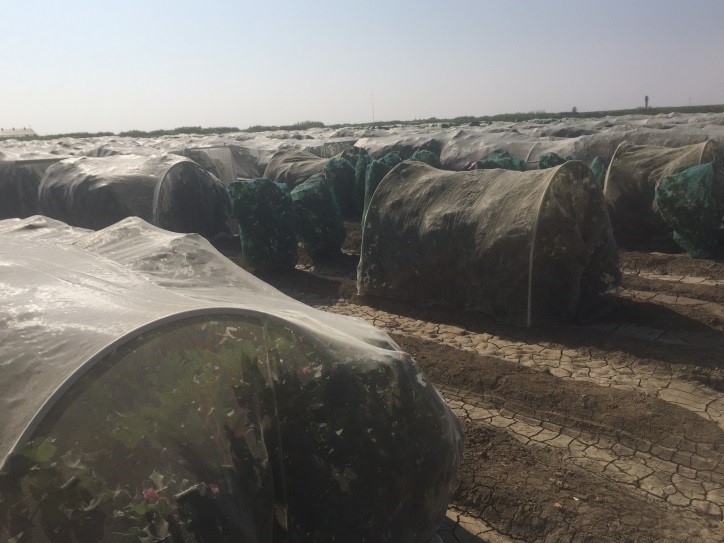
As examples of the work being done on several fronts (Pima, Upland, crosses), in field trials done in heavily FOV4 infested fields, we evaluated lines, crosses and some reselections based on current and prior year screening efforts, with the following examples of some cultivars being advanced in the testing program:
- Egyptian source Pima entries: Three entries selected for advancement based on very good FOV vascular stain ratings.
- Crosses made in 2015 and 2016 (Pima x Upland crosses): 31 entries advanced in selection for seed increase based on very good FOV vascular stain ratings.
- New Entries from Upland Program and Collection of Mauricio Ulloa for 2017: 17 entries advanced in selection for seed increase based on good to very good FOV stain ratings.
- Experiment #9 (based on 2015 and 2016 Pima selections tested for FOV-4 tolerance at Tulare County site): 10 entries advances in selection for seed increase and further testing based on good FOV stain ratings and agronomic characteristics – tested multiple years and sites.
- Experiment #10 (based on 2015 Upland selections tested for FOV-4 tolerance at Tulare County site): 5 entries advanced for seed increase and further testing based on good FOV stain ratings and agronomic characteristic data.
- Experiment # 11 (F-2’s based on 2014 Crosses at Tulare Co. site (some Upland and Upland-by-Pima included) followed by reselections in Greenhouse evaluations: 22 entries advanced for seed increase and further testing based on good FOV stain ratings and agronomic characteristic data.
- Experiment #12 (both Upland and Upland by Pima crosses at Tulare County site): 17 entries advanced for seed increase and further testing based on good FOV stain ratings and agronomic characteristic data.











